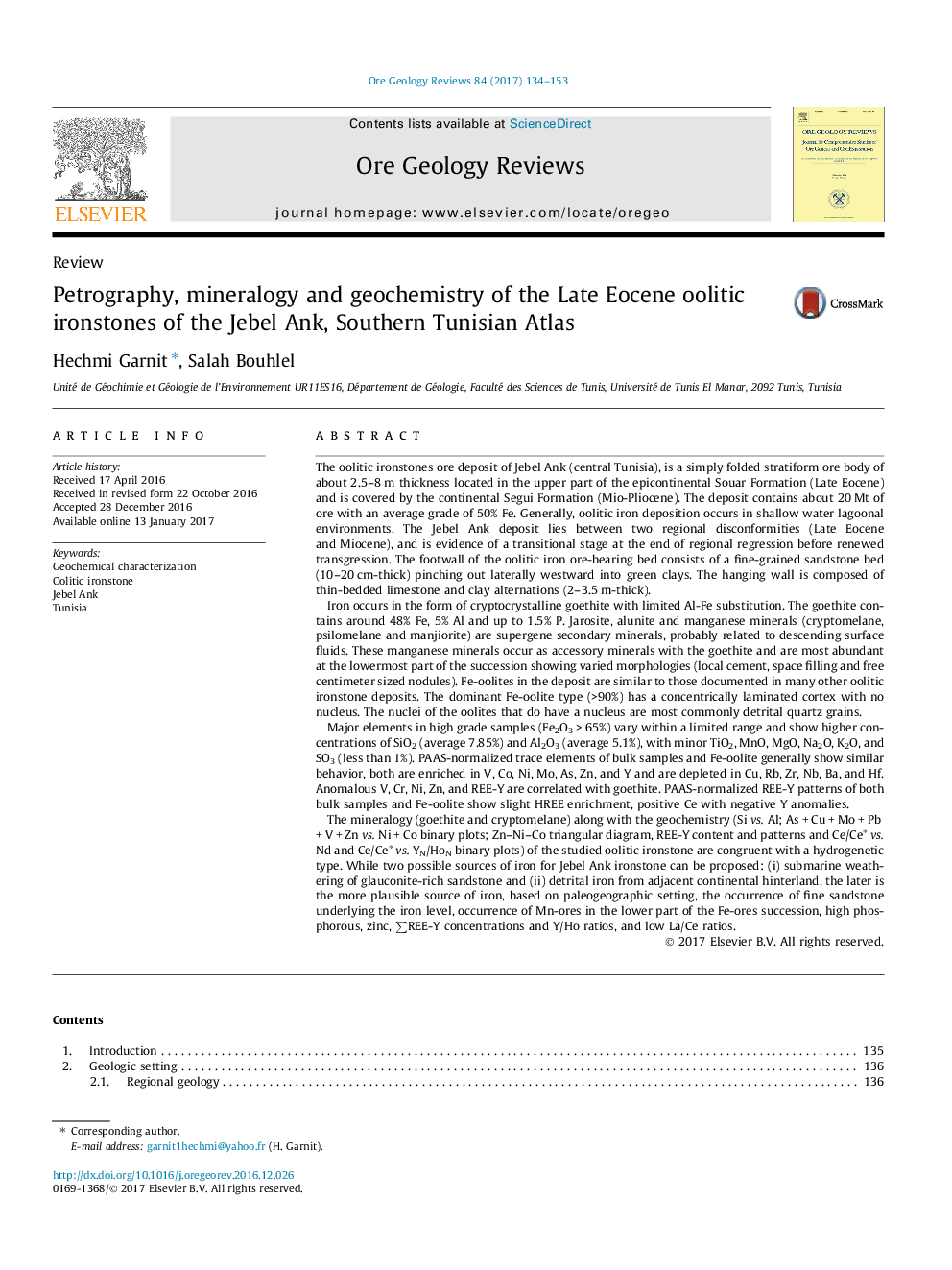| کد مقاله | کد نشریه | سال انتشار | مقاله انگلیسی | نسخه تمام متن |
|---|---|---|---|---|
| 5782474 | 1637223 | 2017 | 20 صفحه PDF | دانلود رایگان |

- This is one of very few description of Tertiary oolitic ironstone of the Jebel Ank deposit.
- Review the geological and mineralogical relationships and presents new spectroscopic and geochemical data.
- We present and discuss the possible iron source(s).
The oolitic ironstones ore deposit of Jebel Ank (central Tunisia), is a simply folded stratiform ore body of about 2.5-8 m thickness located in the upper part of the epicontinental Souar Formation (Late Eocene) and is covered by the continental Segui Formation (Mio-Pliocene). The deposit contains about 20 Mt of ore with an average grade of 50% Fe. Generally, oolitic iron deposition occurs in shallow water lagoonal environments. The Jebel Ank deposit lies between two regional disconformities (Late Eocene and Miocene), and is evidence of a transitional stage at the end of regional regression before renewed transgression. The footwall of the oolitic iron ore-bearing bed consists of a fine-grained sandstone bed (10-20 cm-thick) pinching out laterally westward into green clays. The hanging wall is composed of thin-bedded limestone and clay alternations (2-3.5 m-thick).Iron occurs in the form of cryptocrystalline goethite with limited Al-Fe substitution. The goethite contains around 48% Fe, 5% Al and up to 1.5% P. Jarosite, alunite and manganese minerals (cryptomelane, psilomelane and manjiorite) are supergene secondary minerals, probably related to descending surface fluids. These manganese minerals occur as accessory minerals with the goethite and are most abundant at the lowermost part of the succession showing varied morphologies (local cement, space filling and free centimeter sized nodules). Fe-oolites in the deposit are similar to those documented in many other oolitic ironstone deposits. The dominant Fe-oolite type (>90%) has a concentrically laminated cortex with no nucleus. The nuclei of the oolites that do have a nucleus are most commonly detrital quartz grains.Major elements in high grade samples (Fe2O3 > 65%) vary within a limited range and show higher concentrations of SiO2 (average 7.85%) and Al2O3 (average 5.1%), with minor TiO2, MnO, MgO, Na2O, K2O, and SO3 (less than 1%). PAAS-normalized trace elements of bulk samples and Fe-oolite generally show similar behavior, both are enriched in V, Co, Ni, Mo, As, Zn, and Y and are depleted in Cu, Rb, Zr, Nb, Ba, and Hf. Anomalous V, Cr, Ni, Zn, and REE-Y are correlated with goethite. PAAS-normalized REE-Y patterns of both bulk samples and Fe-oolite show slight HREE enrichment, positive Ce with negative Y anomalies.The mineralogy (goethite and cryptomelane) along with the geochemistry (Si vs. Al; As + Cu + Mo + Pb + V + Zn vs. Ni + Co binary plots; Zn-Ni-Co triangular diagram, REE-Y content and patterns and Ce/Ceâvs. Nd and Ce/Ceâvs. YN/HoN binary plots) of the studied oolitic ironstone are congruent with a hydrogenetic type. While two possible sources of iron for Jebel Ank ironstone can be proposed: (i) submarine weathering of glauconite-rich sandstone and (ii) detrital iron from adjacent continental hinterland, the later is the more plausible source of iron, based on paleogeographic setting, the occurrence of fine sandstone underlying the iron level, occurrence of Mn-ores in the lower part of the Fe-ores succession, high phosphorous, zinc, âREE-Y concentrations and Y/Ho ratios, and low La/Ce ratios.
Journal: Ore Geology Reviews - Volume 84, April 2017, Pages 134-153